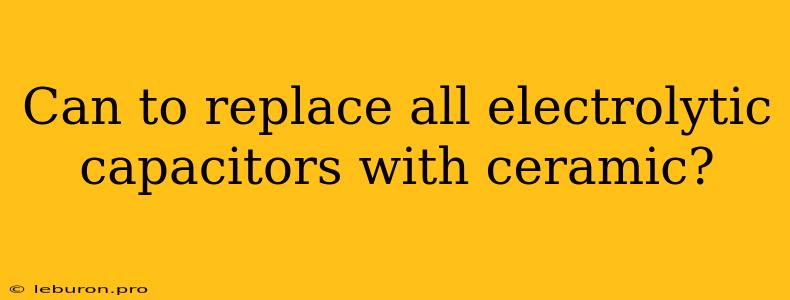The use of electrolytic capacitors in electronic circuits has been ubiquitous for decades. However, with the advancements in ceramic capacitor technology, the question arises: can we completely replace all electrolytic capacitors with ceramic counterparts? While ceramic capacitors offer several advantages, such as higher operating frequencies, smaller sizes, and better temperature stability, there are certain limitations that prevent a complete substitution. This article delves into the intricate relationship between electrolytic and ceramic capacitors, exploring their characteristics, advantages, and disadvantages to understand the feasibility of a full replacement.
The Fundamental Differences: Electrolytic vs. Ceramic Capacitors
Electrolytic capacitors and ceramic capacitors differ significantly in their construction, operating principles, and characteristics. Understanding these differences is crucial for evaluating their suitability in specific applications.
Electrolytic Capacitors
Electrolytic capacitors are known for their high capacitance values in a small footprint. Their construction involves a metal electrode coated with an oxide layer that acts as a dielectric. The second electrode is an electrolyte, usually a liquid or paste, that forms an electrochemical double layer at the interface with the oxide layer. This double layer acts as a capacitance, resulting in large values.
Advantages of Electrolytic Capacitors:
- High Capacitance: Electrolytic capacitors offer significantly higher capacitance values compared to ceramic capacitors of similar size.
- Low Cost: They are generally cheaper to manufacture than ceramic capacitors.
Disadvantages of Electrolytic Capacitors:
- Limited Frequency Response: Electrolytic capacitors have a lower frequency response compared to ceramic capacitors.
- Polarity Sensitivity: They are polarity-sensitive, meaning they must be connected with the correct polarity to avoid damage.
- Limited Temperature Range: Electrolytic capacitors have a limited temperature operating range and are prone to leakage currents at higher temperatures.
- Lower Reliability: They have a shorter lifespan and are more prone to failure compared to ceramic capacitors.
Ceramic Capacitors
Ceramic capacitors utilize a ceramic material as the dielectric, sandwiched between metal electrodes. The ceramic material's dielectric constant determines the capacitance value.
Advantages of Ceramic Capacitors:
- High Frequency Response: Ceramic capacitors exhibit excellent high-frequency performance due to their low internal resistance.
- High Stability: They offer better stability over temperature and time compared to electrolytic capacitors.
- Non-Polarity: Ceramic capacitors are non-polar, meaning they can be connected in any direction.
- Higher Reliability: They generally have a longer lifespan and higher reliability compared to electrolytic capacitors.
Disadvantages of Ceramic Capacitors:
- Lower Capacitance: Ceramic capacitors typically offer lower capacitance values than electrolytic capacitors for a given size.
- Higher Cost: They are generally more expensive to manufacture than electrolytic capacitors.
Can We Replace All Electrolytic Capacitors with Ceramic?
While ceramic capacitors offer numerous advantages, completely replacing all electrolytic capacitors with them is not feasible due to several key limitations.
1. Capacitance Values: Ceramic capacitors are limited in their capacitance values, particularly for high-capacitance applications such as power supply filtering, energy storage, and DC blocking.
2. Cost: Replacing electrolytic capacitors with ceramic equivalents in high-capacitance applications would significantly increase the overall cost due to the higher cost of ceramic capacitors.
3. Size and Footprint: Ceramic capacitors often require larger physical footprints to achieve the same capacitance as their electrolytic counterparts. This can pose a challenge in space-constrained designs.
4. Voltage Rating: For high-voltage applications, ceramic capacitors may not offer the same voltage rating as electrolytic capacitors, requiring multiple ceramic capacitors in series to achieve the desired voltage rating.
5. Leakage Current: Ceramic capacitors generally have lower leakage currents compared to electrolytic capacitors, but for some applications, this may not be sufficient.
Finding the Right Balance: Choosing Between Electrolytic and Ceramic Capacitors
Instead of aiming for a complete replacement, the key lies in understanding the specific requirements of each application and choosing the capacitor type that best meets those requirements.
-
High Capacitance Applications: Electrolytic capacitors remain the preferred choice for applications demanding high capacitance values at relatively low cost. They are widely used in power supply filtering, energy storage, and DC blocking circuits.
-
High Frequency and Stability: For applications requiring high frequency performance and excellent temperature stability, ceramic capacitors are the preferred choice. They are widely used in high-speed digital circuits, RF applications, and precision timing circuits.
-
Compact Size and Low Leakage Current: For space-constrained designs and applications demanding low leakage current, multilayer ceramic capacitors (MLCCs) are often the ideal solution. MLCCs provide high capacitance values in a small footprint with low leakage current.
Conclusion: The Future of Capacitors
The ongoing advancements in ceramic capacitor technology, such as the development of high-capacitance ceramic capacitors, are steadily expanding the range of applications where ceramic capacitors can effectively replace electrolytic capacitors. However, electrolytic capacitors will likely continue to play a vital role in electronics for years to come due to their high capacitance values at low cost. The future lies in utilizing the strengths of both capacitor types to achieve optimal performance, reliability, and cost-effectiveness in diverse electronic applications.
